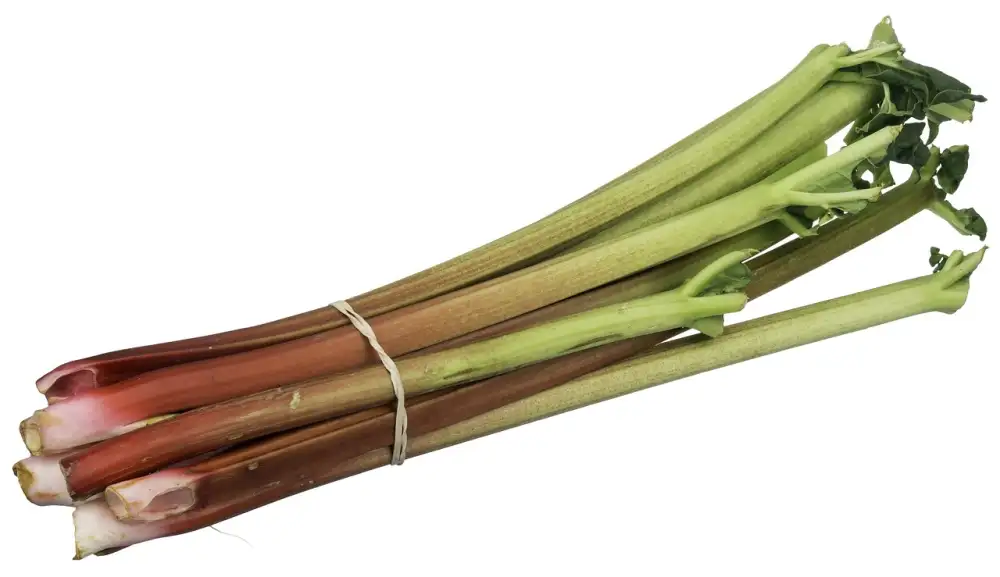Master the Art of Cooking Rhubarb: A Delectable Recipe Guide

- Selecting Fresh Rhubarb: Tips for Choosing the Best
- Preparing Rhubarb: Cleaning and Cutting Techniques
- Cooking Methods: Stewing, Baking, or Roasting Rhubarb
- Flavor Enhancements: Sweeteners and Spices to Complement Rhubarb
- Recipe Ideas: Rhubarb Compote, Crumble, and Pie
- Serving Suggestions: Enjoying Cooked Rhubarb in Various Dishes
- Storage Tips: Preserving Cooked Rhubarb for Future Use
Rhubarb, known for its vibrant pink color and tangy flavor, is a versatile ingredient that can be used in both sweet and savory dishes. This perennial vegetable is often mistaken for a fruit due to its use in desserts like pies and crumbles. Rhubarb is rich in vitamins K and C, as well as fiber, making it a nutritious addition to your diet. Its unique taste adds a refreshing tartness to dishes, making it a favorite among chefs and home cooks alike. Whether stewed, baked, or roasted, rhubarb brings a delightful twist to any recipe.
Selecting Fresh Rhubarb: Tips for Choosing the Best
When selecting fresh rhubarb, look for firm stalks that are crisp and free from blemishes or soft spots. The color can vary from pale pink to deep red, depending on the variety, but vibrant hues indicate freshness. Avoid rhubarb with wilted or yellowing leaves as this can be a sign of age. Opt for medium-sized stalks as they tend to be more tender than larger ones. Remember, the thinner stalks are generally more tender and flavorful compared to thicker ones.
Preparing Rhubarb: Cleaning and Cutting Techniques
When preparing rhubarb, it is essential to start by thoroughly cleaning the stalks. Rinse them under cold water to remove any dirt or debris. Next, trim off the leafy tops and the tough ends of the stalks. Rhubarb can be quite fibrous, so it's recommended to peel off any stringy outer layers with a vegetable peeler if needed. Once cleaned, cut the rhubarb into pieces according to your recipe's specifications. Remember to handle rhubarb with care as its leaves contain oxalic acid, which can be toxic if ingested in large quantities.
Cooking Methods: Stewing, Baking, or Roasting Rhubarb
When it comes to cooking rhubarb, there are several methods you can use to bring out its unique flavor and texture. One popular way is stewing rhubarb, where you simmer chopped rhubarb with sugar and a little water until it softens into a delicious compote. Baking rhubarb is another fantastic option, as it retains its shape and tangy flavor when roasted in the oven with sugar or honey. Roasting rhubarb is a less common but equally flavorful method, where you can caramelize the rhubarb by roasting it at high heat with a touch of balsamic vinegar for added depth of flavor. Each method offers a different culinary experience, allowing you to explore the versatility of this vibrant ingredient in your cooking endeavors.
Flavor Enhancements: Sweeteners and Spices to Complement Rhubarb
When it comes to enhancing the flavor of rhubarb, sweeteners and spices play a crucial role in balancing its natural tartness. Common sweeteners like sugar, honey, or maple syrup can help mellow out the sharpness of rhubarb while adding a pleasant sweetness. Additionally, spices such as cinnamon, ginger, or vanilla can complement the tangy flavor of rhubarb with their warm and aromatic notes. Experimenting with different combinations of sweeteners and spices can elevate the taste of your rhubarb dishes to new heights.
Recipe Ideas: Rhubarb Compote, Crumble, and Pie
Rhubarb is a versatile ingredient that shines in various recipes. For a quick and easy option, try making a rhubarb compote by simmering chopped rhubarb with sugar and a splash of water until it breaks down into a chunky sauce. This compote can be served over yogurt, ice cream, or oatmeal for a delightful treat.
If you're in the mood for something more indulgent, consider baking a rhubarb crumble. Mix sliced rhubarb with sugar and your favorite spices, then top with a buttery crumble made of flour, oats, sugar, and butter. Bake until the topping is golden brown and crispy for a comforting dessert that pairs perfectly with vanilla ice cream.
For those looking to showcase rhubarb in a classic way, why not bake a rhubarb pie? Fill a flaky pie crust with sweetened rhubarb filling and bake until the juices are bubbling and the crust is golden brown. Serve warm with a dollop of whipped cream or a scoop of vanilla ice cream for a timeless dessert that never disappoints.
Serving Suggestions: Enjoying Cooked Rhubarb in Various Dishes
Cooked rhubarb is a versatile ingredient that can be enjoyed in a variety of dishes. One classic way to savor stewed or baked rhubarb is by serving it over vanilla ice cream or yogurt for a simple yet delightful dessert. For a more sophisticated touch, consider layering cooked rhubarb between sponge cake layers and topping with whipped cream for an elegant trifle.
Rhubarb compote can also be paired with savory dishes like roasted pork or grilled chicken to add a tangy contrast to the richness of the meat. Additionally, incorporating cooked rhubarb into breakfast options such as oatmeal, pancakes, or French toast can elevate the flavors and provide a unique twist to your morning meal.
For those looking for a refreshing drink option, mixing cooled rhubarb compote with sparkling water or lemonade creates a deliciously tart beverage perfect for warm summer days. The possibilities are endless when it comes to serving cooked rhubarb – experiment with different combinations to discover your favorite way to enjoy this delectable ingredient.
Storage Tips: Preserving Cooked Rhubarb for Future Use
After cooking rhubarb, allow it to cool completely before storing. To preserve cooked rhubarb for future use, transfer it into airtight containers or freezer bags. Label the containers with the date to keep track of freshness. Cooked rhubarb can be stored in the refrigerator for up to 5 days. For longer storage, freeze cooked rhubarb for up to 6 months. When ready to use, thaw frozen rhubarb in the refrigerator overnight or gently reheat it on the stove for immediate use in recipes like jams, sauces, or desserts. Proper storage techniques will help maintain the flavor and texture of cooked rhubarb over time.
In conclusion, mastering the art of cooking rhubarb opens up a world of culinary possibilities. Its unique tart flavor and vibrant color make it a standout ingredient in both sweet and savory dishes. By following the tips on selecting, preparing, and cooking rhubarb, you can unlock its full potential in recipes like compotes, crumbles, and pies. Embrace the distinct taste of cooked rhubarb and experiment with different flavor combinations to create delightful dishes that will surely impress your taste buds.
Published: 08. 03. 2024
Category: Recipes



